Matter
I originally thought of calling this chapter “matter”, but I realised that the concept of matter is problematic, in addition to being narrower than space-time. This is why I ended up choosing the title “Space and Time”.
What is matter? Does anything like matter exist? Yes, but we must again bear in mind the level of truth we look at it from. We are on, say, the fourth level, “Human – Space and Time”. And from this perspective, matter, as described by the latest scientific knowledge, undoubtedly exists and must be addressed.
The multi-dimensional universes
The latest scientific research attempting a unified theory of everything says that our Universe is structured in basic building blocks, one-dimensional strings. Depending on how they vibrate, the strings manifest like individual particles—the basic components of matter. This means that everything is reduced to vibration, just like almost all ancient mythologies say.
According to one of the assumptions of Superstring Theory, our Universe has fully developed 3 special dimensions and 1 time dimension, and 7 (6) coiled space dimensions. Parallel universes exist in the same space-time with different developed and coiled dimensions. Theoretically, this gives many possibilities, like the existence of 7 parallel universes, as some mythological and esoteric sources say— universes with 3 space and 1 time dimensions, that is. Universes similar to ours and existing parallel to it, which, under certain conditions, would allow passage between them. The universes not parallel to ours are, of course, infinite, but they are beyond our possibilities of space-time knowledge.
In addition, we can also imagine models of universes with more dimensions, which we can perceive on our sensory level as a penetration into our four-dimensional universe. From this, we can deduce the hypothesis that humans (and not only humans) are a penetration of the multi-dimensional Being into our Universe (space-time). This could explain a lot of things that seem incomprehensible. Our senses are unable to perceive the multi-dimensionality of objects and phenomena and therefore we do not understand them.
Randomness
The computer game Tetris could serve as an example. The game consists on placing objects of different shapes on a base in order to fill it. It can be played in two basic levels – 2D and 3D. Fig. 12 illustrates the principle for those who do not know the game.
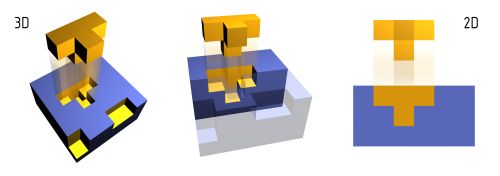
Fig. 12
Now imagine that the computer generates the objects in 3D, but the screen shows them only in 2D. From the perspective of the player, there could be a situation where even though an object (in 2D) is placed correctly, one of the solutions is considered right (see Fig. 13a) and another, wrong (see Fig. 13b).
This is because the computer assesses the object as 3D and, given its shape in the third dimension, one can be placed on the base and the other, not.
This is because the computer assesses the object as 3D and, given its shape in the third dimension, one can be placed on the base and the other, not.
The player, who only perceives what is on the screen, sees that one of his—in 2D—correct solutions is accepted and another is not.
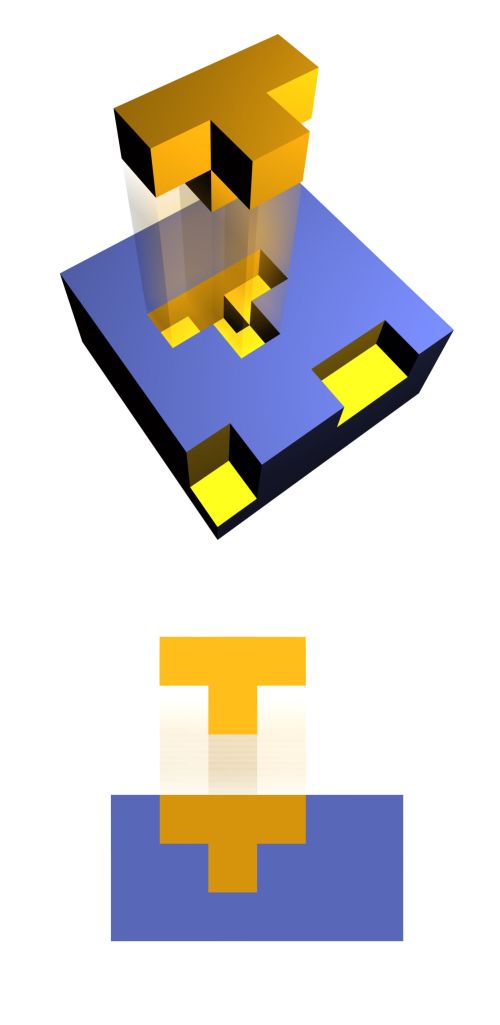
Fig. 13a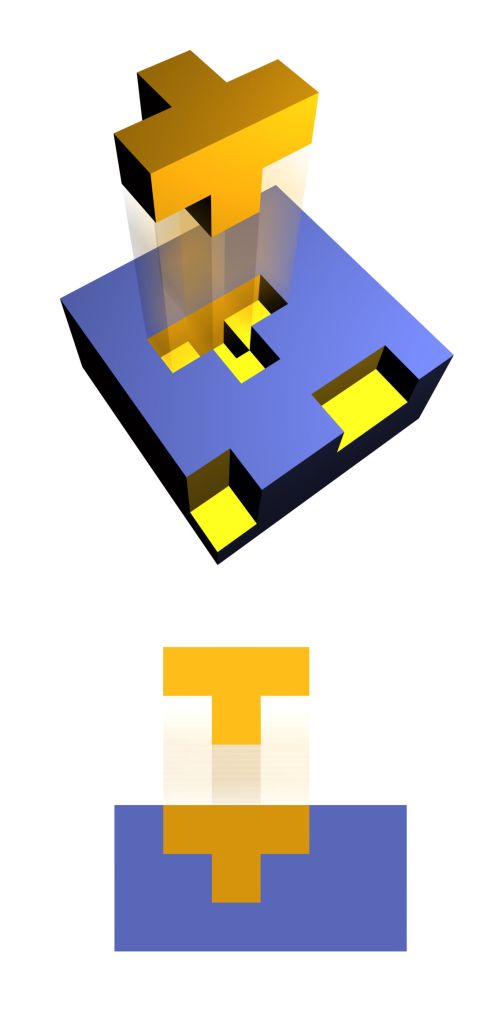
Fig. 13b
He lacks information (does not see the object in 3D) and can’t see why one of his solutions was considered correct and another incorrect. And this lack of information leads him to believe that success in the game depends on chance.
If we assume that the multi-dimensional universe is true, and that we are able to perceive only 4 dimensions, we can draw the logical conclusion that assessing a given phenomenon as random is the result of a lack of information.
Once again, a computer game can serve as a good example to explain the principle of randomness.
Computer games have random situations players have to solve. They are generated by a special feature: a random number generator, which generates what for us is an unpredictable sequence of numbers that we see as random. But its algorithm was created by a programmer and the generation of those numbers is no longer random.
Time
According to some theorists, time can be understood as the fourth dimension. Our perception of time is nothing but the way we perceive the fourth special dimension.
On this notion, it is possible to establish a model to understand what, from the perspective of our experience, is incomprehensible: that past, present and future exist simultaneously.
We only need to imagine a world where space is two-dimensional and the third dimension is time. It is the commonly used way to explain some of the principles of the multi-dimensional word, the model of a space (or space-time) with one less dimension.
As Fig. 14 illustrates, the observer, who is outside this space-time, can perceive past, present and future simultaneously. With this model it is possible to understand the claims of some religious and esoteric doctrines that everything exists and happens at the same time.

Fig. 14
A film is another model to understand that everything exists simultaneously. This is perhaps a more illustrative example as it can also show several perspectives.
The first is the perspective of the characters, which are not able to perceive the film as an illusion, but as reality.
A second perspective is the actors’, who play the characters in the film. They are able to perceive the illusion of the characters they play, but mostly, they do not perceive the film as a whole (assuming that none of them is the director).
A third perspective is the audience’s. They are able to perceive the illusion of the film and understand the story, but they perceive it gradually, time-wise.
A fourth perspective is the entire film at once, the unrolled celluloid strip with all the frames, all the images in a single instant.
In this case, the observer will perceive simultaneously what in the film the past, present is and future. In a single instant, they will perceive simultaneously all the points in time and plot. For them, time as we understand it does not exist; it’s actually the fourth special dimension.
The paradox is one of the attributes of truth. Those who do not accept this fact, have no chance to even see the truth. Many eastern philosophers have tried to describe truth almost exclusively with paradoxes. The paradox is an indispensable part of the formulation of the highest truths.
One such paradox is that we, as beings, are on the one hand eternal and, on the other we go through creation, change and extinction (not just a change of form).
Logically, it follows that, even if I am “now” (and there is no point doubting that because all considerations would lose their meaning) and there is nothing but “now”, I am constant. To make it clearer, I will again use a film. Each of the characters appears only in some parts of the film, but, when looking at the unrolled film strip, we see them, though not in all the frames.
I put into consideration the hypothesis that time, as the fourth special dimension, is also subject to the gravitational curvature. On the basis of this hypothesis, it is therefore likely that, when observing a time-line endlessly in only one direction, after a long time, and given its dimensionality and curvature, we will return to the same point in time, as it is assumed for space. In this regard, I remind you of the model of the evolution of the Being (see Fig. 7).
Since it can be assumed that there are more time dimensions that, figuratively, are not parallel to ours, it is theoretically possible to imagine a different time dimension moving significantly faster to a different point in our time dimension, or even to the past. Assuming a multi-dimensionality of time, it is possible to also imagine its branching.
Space-time in this concept does not allow for time paradoxes, often used in science fiction. Any change would alter the space-time—past, present and future—including the observer’s, who, as part of that system, would not be aware of it. A change in the past, the present and the future will result in a change in the consciousness of the observer, the information about the future and the present stored in their memory.
The fractal arrangement of space-time
Space-time is arranged fractally (the concept of fractal is very well explained in James Gleick’s “Chaos”, see Figs. 15a and 15b for illustration), and hence in a non-random structure. This fractal arrangement can be proven with modern scientific methods and, in my opinion, the theories in the aforementioned book make it more or less clear.
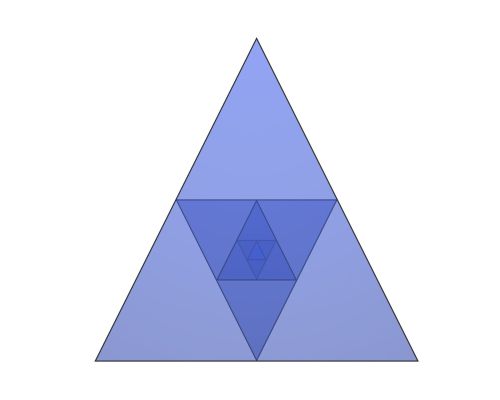
Fig. 15a – 2D fractal
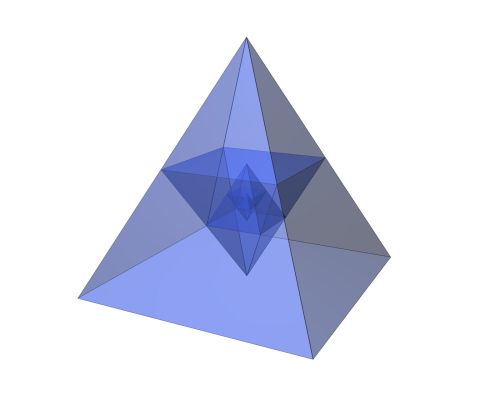
Fig. 15b – 3D fractal
In fact, the fractal arrangement of space (matter) is commonly seen as self-evident.
The similarity of the model of an atom or a molecule with the model of the solar system, galaxies and supergalaxies is well known.
The aforementioned book also gives examples of fractal arrangements of shapes like coastlines, i.e. matter (space). However, it’s not yet widely used in intellectual constructs, even for space-time or the history of people, nations, cultures, civilisations or human-kind, but for the evolution of the Earth, the Solar System, Galaxies and the Universe.
The theory of the fractal space-time arrangement implies that each point of space-time can be expressed not only through a quantitative description of the spatial and temporal coordinates, but that it also has a qualitative expression, which is different from other points in space-time. At the same time, however, due to the fractal arrangement of all points in space-time, there are some points that have the same or similar qualities. Since this is a four-dimensional space-time, this intellectual construct should also consider four-dimensional fractals.
Astrology
The theory of the fractal arrangement of space-time provides a scientific substantiation of astrology. This stems from the fact that space-time has a non-randomly arranged structure, and a specific time in a specific place has its own quality, different from others, while being also cyclical and therefore predictable. This is the basis of astrology as a scientific discipline.
From the perspective of astrology (and not only astrology, but the same principle also applies to the card reading, the I-ting, and even more exotic forms of divination like the entrails of animals, tea leaves, etc.), each point in space-time (a specific moment at a specific place) has its quality expressed in the relationships between several basic principles.
A big advantage of astrology when compared to other methods, thanks to which it has become so recognised and widespread, is that the relationship of the basic principles of a certain point in space-time is given by the position of celestial bodies intended as a representations of certain basic principles (e.g. Mars: struggle, Venus: love).
The position of each celestial body can be relatively easily (and very easily with a computer program) calculated for any time and place in the past or the future.
The inaccuracy of astrological predictions is due to several factors, one of the most important of which is undoubtedly the quality of the astrologer. In most cases, however, the main reason is a lack of information.
It is very similar to meteorology, which nobody would dare question is a true science. And yet, in the minds of most people, the weather forecast is famous for its inaccuracy.
The insufficient knowledge of all the initial conditions causes that some weather forecasts end up being considerably different to the actual weather. And yet, the science in the methods of meteorology is acknowledged even by the most sceptical scientists.
Astrologers mostly work only with one piece of the system and, based on the calculation of the mutual positions of planets, establish the basic principles that affect that piece in a certain point in space-time. This leads to the possible inaccuracies of horoscopes and astrological predictions. With more information about a person and the environment where he or she lives (e.g. the horoscopes of their parents, partners, children, but also nation, country and place), a horoscope could be made more accurate, determining in more detail how the basic principles that affect that person in a certain point in space-time could manifest.
The quality of the specific point in space-time where the being is incarnated is crucial for that being.
The time and place of birth define rather accurately a specific point in space-time, the most important one as it determines the character of the Cosmic Game in which the being is incarnated. This is why the exact place and time of birth is crucial for a good horoscope.
The concrete character in the Cosmic Game will determine which principles of the Being the character will experience, with all the mental and physical attributes to experience them. It determines which principles will enrich the knowledge of the Being, or the Being itself, during this incarnation.
And this is why astrology is able to determine which basic principles a person will experience during its incarnation and, to a lesser extent, when. How and when those basic principles will manifest in the life of a person will depend on the person.
The knowledge of a quality horoscope will allow a person to experience those principles consciously.
The misunderstandings common in the application of astrology result from the fact that people want to use it in order to avoid experiencing these basic principles, if possible, changing the external circumstances instead of themselves, which is a fundamental mistake. Only changing oneself from a perspective exceeding one lifetime makes sense.
This kind of misunderstanding is also characteristic of other types of predictions of the future well known from fairy-tales, and in particular, Greek tragedies, of which Oedipus is probably the most famous example.
I will use again the analogy of the weather. Knowing that the forecast says it will rain in the afternoon will not allow normal people to prevent the rain (maybe with the exception of shamans), but thanks to it, they will take an umbrella when leaving home in the morning so they won’t get soaked when coming back from work.
This analogy shows that astrology uses approximately the same scientific methods as meteorology for its predictions, and that it’s more or less equally (un)successful and for more or less the same reasons.
The reason why I’m dedicating so much space to astrology is that it is a good example of a science discipline considered a pseudo-science because it is judged only from the perspective of the fourth level of truth, “Human – Space and Time” and its incomplete model of existence. But the entire model is necessary to understand the truth.
With a comprehensive knowledge of the entire model of existence, it is possible to get the right answers to the right questions.
Knowing the structure of a system allows inferring the properties of its elements, already from the knowledge of the location of an element therein.
It’s similar to Mendeleyev’s periodic table of the elements, where putting an element in the right place of the table allows predicting its properties, even if the element itself is yet to be found in nature or created in a laboratory. Likewise, the properties of a new element can serve to deduce its expected location in the table.
This is why at least a basic knowledge of an entire system, its structure and principles is very important to know the different elements thereof.
This is the limit of the knowledge of modern science, which comes from a model of existence limited to the perspective of the fourth level of truth “Human – Space and Time”. This is not to say that this model is completely false, it’s just incomplete.
Nevertheless, since our sensory perception and experience are largely in line with it, it is considered true, and the phenomena that not conform to it are mostly categorised as scams, hallucinations, mistakes or, by an exceptionally religious part of society, miracles. A more progressive part of the scientific community says that they are based on physical processes still unknown to us.
Paradoxically, this incomplete model of existence is manifested most clearly in the sciences that deal with the human such as medicine or psychology, and which have the closest relation and the most direct effect.
Until medicine begins to understand the human as part of a multi-dimensional Being and continues to see it as some sort of perfect machine controlled by complex chemical and physical processes, it won’t be able to solve the problem: human health.
Without a basic understanding of what a human is, medicine can only be successful in “fighting” each disease.
I put the word “fighting” in quote marks because I wanted to draw attention to the terminology that medicine uses, and that characterises it. Medicine by the most part doesn’t address the problem of the complex human health, and in many cases doesn’t even pretend to, but fights with disease. How appropriate.
Homoeopathy
In this regard, I’d like to use as example one of the mistakes of modern medicine, also caused by the incomplete model of existence, while also trying to defend the scientism of homoeopathy. Scientists are willing to accept the therapeutic effect of this method only as a result of the placebo effect.
Let’s forget for a moment that, according to the theory of mentalism, everything is mind and therefore any treatment, including surgery, is actually placebo effect (though this is a great simplification, with some degree of exaggeration).
The basic principle of any therapy (and maybe even life) is the transfer of information. According to the main opponents of homoeopathy, if there isn’t a single molecule of the original active substance in the homoeopathic substance, the transfer of information can’t take place.
But contemporary science has been able to prove that this opinion is inaccurate, if not false. Rigorous scientific research conducted on frozen water under a strong microscope has proven that the molecules crystallise differently if they are exposed to different energy-information influences.
The simplest case was when water was exposed once to the effects of positive energy and then to the effects of negative energy (meaning the emotions of the subject). In the first case, the ice crystals had a beautifully harmonic arrangement, in the other, it was chaotic.
The energy-information arrangement of a homoeopathic substance is affected by the original substance, which is potentiated (diluted many times) and this energetic information is what cures a person, acting on their disrupted energy-information arrangement. I expressly point out that, when properly used, homoeopathy cures a person, and not only of their disease.
The homoeopathic medicine itself is only a carrier of information. To use another analogy, it is the same way information is recorded on a magnetic tape.
Music is a beautiful example. The origin of information contained in a magnetic tape with a music recording is the composer, who can’t be found in any form on the tape, unless they are also a singer or a player, and even they aren’t on the tape, either. In the case of interpreters, it’s only about the information on how they interpret the piece.
The fact that a patient is given the right information, even if the remedy may not contain the origin thereof, is based on the second fundamental principle of homoeopathy (the first being like-cures-like). If someone does not understand it or, for some reason, refuses to understand it, any debate on the efficacy of homoeopathy is pointless. The usual argument for such person is that the remedy doesn’t have any substance that may give any information, and it is final.
The evolution of the Universe
There is a problem that constantly appears in scientific journals dealing with cosmogony: setting the initial conditions or, in other words, determining the natural laws that lead to the creation of the universe as we observe it.
This also means that those conditions were set so that they lead to the evolution of the universe and that there would be something, or someone, able to observe that universe, in our case, the human.
According to the latest research, it seems that the initial conditions were set very precisely, because a minor change in any of them could have prevented the formation of a universe in which life and the existence of humans could appear.
Therefore, God (meaning the Creator of our Universe) must have worked really hard, and maybe made innumerable attempts, before succeeding with this, our unique Universe.
God has it much easier. He doesn’t need to set any initial conditions, He can set a desired state somewhere in the future; using a technical term, attractor. I will use another analogy to better explain it.
If I throw a lot of marbles on a flat, horizontal surface, they will probably meet at one point, almost zero (see Fig. 16a).
To achieve this non-randomly, I would need to precisely calculate the initial speed and spin of each marble and then drop them from a separate device at the calculated speed and spin. The calculations would have to count with the marbles bumping into each other.
I’m afraid that, already with 50 marbles, it would be an unattainable task for modern science.
However, if I dropped the marbles in a channel conveniently ending in a large hole, the probability that all the marbles will be in one place is 100%, regardless of their number and how they were put in motion (see Fig. 16b).
God doesn’t play with dice God plays with us a game similar to some slot machines. Beings—the marbles—are dropped by God on an inclined plane and they roll down in different ways to a single hole. In this model the starting and the ending hole are in the same point due to the curvature of space-time. Along the way, there are obstacles representing the divine and natural laws and the laws of the Cosmic game, which determine the course of the Beings through time and space, and their fate.
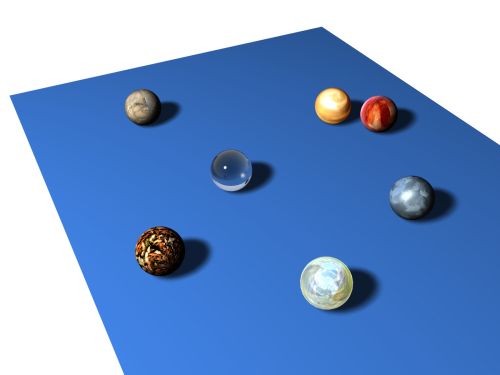
Fig. 16a
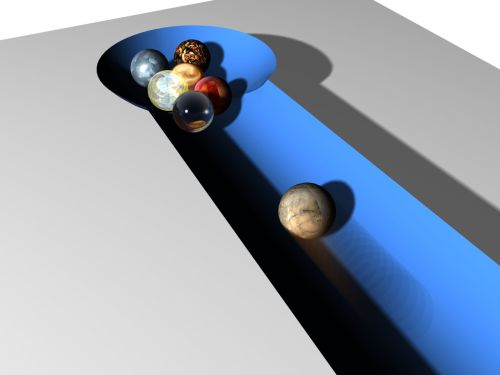
Fig. 16b
Paranormal phenomena
Telepathy, telekinesis, teleportation, levitation, OBE, clairvoyance, precognition, materialisation and other phenomena considered miracles are easily understandable and explainable under the theory of mentalism. If we consider that everything is a projection of the World Mind, and that everything is only thought, we can easily understand their existence and how they work.
The existence of telepathy, telekinesis and clairvoyance has been proved beyond doubt with the methods of modern established sciences (even if some scientists, out of ignorance or intentionally ignoring the facts, say otherwise).
It is harder, however, to answer the question why these phenomena work only sometimes, somewhere and on some people. A detailed explanation of this question is beyond the scope of this book, but generally speaking, it could be said that, when assessing a concrete case, the specific conditions should be taken into account.
The most important of which include the development level of the person related to the phenomenon, their faith in the existence of the phenomenon and the quality and strength of the morphic field in a given area, but also how much mental energy the person is putting (with strong emotions being a good breeding ground).
An example is the well-known fact that phenomena like OBE, telepathy, telekinesis or materialisation work better in environments shielded from the human morphic field such as mountain areas above 4000 metres, deserted islands, places deep in the jungle or in space.
Likewise, altered states of consciousness have a very positive effect because they remove the mental block, the disbelief in the possibility of these phenomena.
In contrast, and for the same reasons, these phenomena don’t work when they are conducted as experiments under the observation of non-believing scientists because their morphic field of disbelief is too strong. And this isn’t contrary to the current scientific knowledge, which has proven that the person of the experimenter has an effect on the results of the experiment.
Shlédnutí: 85